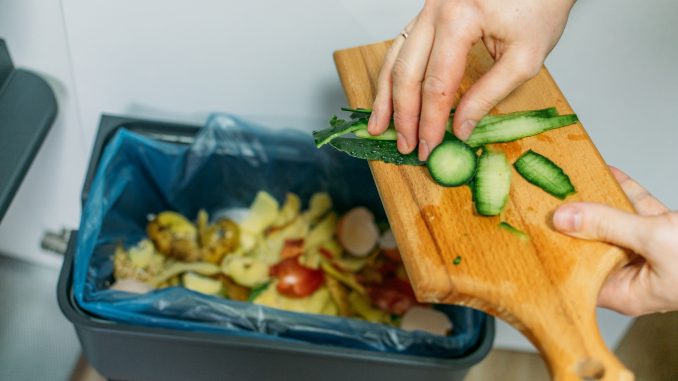
California’s wildfire seasons are now a year-round threat. Historically, fire season spanned from late May until October, but due to a combination of increased temperatures and decreased rainfall, seasons are beginning sooner and ending later. More than half of the state’s wild land—at least 25 million acres—face a “very high” or “extreme” fire threat according to the California Department of Forestry and Fire Protection. The most destructive and deadliest fire in California’s history—2018’s Camp Fire—burned 153,336 acres and claimed the lives of 85 people. While the cause was determined to be power lines, climate change arguably contributed to the hotter and drier conditions that enabled it.
With SB 1383, California is taking steps to combat climate change and the destruction it brings. The regulation, which was enacted in 2016, requires a 75% reduction in organic waste disposal and 20% of edible food waste diverted away from landfills by 2025. Keeping organic waste out of landfills is a big step in reducing climate pollutants. As it decomposes, organic waste like yard clippings, paper and food waste creates greenhouse gasses like methane and carbon dioxide. SB 1383’s goal is to reduce the amount of organics—currently a third of all landfill materials, nearly 39 million tons—languishing in landfills and put it to good use as a renewable energy source, environmentally responsible compost or to stock shelves of food pantries across the state.
“Greenhouse gasses don’t just stay in one place, they go up into the atmosphere. It’s a statewide goal that California has to meet those greenhouse gas emission reductions,” says Staci Heaton, Deputy Executive Director of the Rural Counties Environmental Services Joint Powers Authority, which represents Tehama and 25 other rural counties across California. “What we’re seeing is the effect of climate change in California with more intense winters, more intense summers, … our more intense and more frequent wildfire seasons, all of those things, as the state has said, are a product of greenhouse gas emissions causing climate change.”
As a rural county, Tehama faces challenges that many urban and suburban communities don’t: Sparse populations, unpaved roads that are hard on waste collection vehicles and many residents who self-haul to the landfill. Tehama County is temporarily exempt from several SB 1383 requirements until January 2027, when a collection program must be up and running. Officials with the Tehama County Solid Waste Management Agency are working with CalRecycle to find solutions that work for residents and comply with SB 1383 regulations. To date, Tehama County is responsible for implementing edible food donations, which require generators like supermarkets and grocery stores, hospitals, schools and restaurants to donate edible items to food banks and other organizations.

Tehama County Solid Waste Management Agency
“We’re trying to figure out what is going to work the best, but also keep our Agency and the county and our member jurisdictions in compliance,” explains Paul Freund, Organic Materials Program Coordinator with the Tehama County Solid Waste Management Agency. “Waste reduction is the first thing we want to look at. If you think back to grade school with the three Rs—reduce, reuse, recycle—reduce is the least commonly used of the three Rs. We want to look at reducing any kind of waste generation in the first place.”
Reducing the amount of organic waste in landfills and repurposing materials has multiple long-term benefits for both local communities and the state as a whole.
- Landfill space is limited. Diverting organic materials extends a facility’s usable life.
- Compost use reduces the need for petrochemical-based pesticides and fertilizers, which reduces the risk of groundwater pollution.
- Compost and mulch prevent erosion and stabilize fire-scarred areas, construction and roadwork sites.
- Organic waste is the power behind multiple renewable energy systems, including biomass and anaerobic digestion facilities, which capture greenhouse gasses, refine them and put them to use powering fleet vehicles or contributing energy into the power grid.
“With organic materials, it’s something you have the power in your own backyard to effectively manage.”
Paul Freund
Organic Materials Program Coordinator, Tehama County Solid Waste Management Agency
While it’s important to correctly repurpose all recyclable materials, Freund points out that organic waste is a valuable resource that can be processed and put to good use locally.
“We rely on exporting so much of our recyclable materials whereas with compost, you don’t even have to leave the farm. All your other commodities—your aluminum, plastics, your paper—all of those things rely on being shipped far distances to be re-manufactured into more materials,” he says. “With organic materials, it’s something you have the power in your own backyard to effectively manage. You can’t set up a paper processing plant in your backyard and effectively recycle paper. You can’t set up a foundry and recycle your own aluminum effectively and safely in your own backyard. … With food scraps and yard trimmings, you have the control to prevent it from going to a landfill.”

For more information on SB 1383 and how it will affect Tehama County residents, visit www.tehamacountylandfill.com. This article was funded by a grant from CalRecycle.

